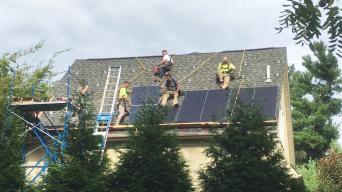
Betsy Gets Solar Panels, Part 2: Shedding Light on the Details of Getting and Living With Solar

Getting serious about a solar array? The first step is determining if your home is a good candidate for solar. South or west exposure is optimal, with no tree cover. Google Earth and other online tools can pinpoint your exact location and estimate its solarization.
If you live in Philly and sign up through Solarize Philly, they connect you to a solar contractor who will require access to your PECO account. They evaluate your site remotely and come to your home with a plan, designing a system to match your electrical consumption.
While the full price of the array is due in installments, for 2019 there is a 30% credit on your tax returns when you file them. (The credit will be 28% in 2020). Financing is available through Solarize Philly and your contractor, with payments equaling about what you would have paid for your electric bills. Like a mortgage, when you make your final payment, you own the system. Thus far, the numbers show that a solar array adds to a home’s value. The number of years it takes to pay for itself depends on output, consumption, and other variables; generally in 8-15 years.
When you sign a contract, the panels will be ordered. A few months later, your installation date will be scheduled. This typically takes a day, with minimal access to your house. They will also install a solar inverter, which converts the variable direct current output of a solar panel into alternating current. Once the system passes inspection, PECO swaps out your meter for a reverse meter setup and then your system will be activated.
An app provides you with a tremendous amount of data about your system’s output. In Philly, systems produce the most in summer when the days are longest, and the least during winter’s shortest days. Sunny days in spring and fall will be the most likely to cover your household consumption. Cloudy, rainy and snowy days still produce power, but significantly less.
Abby and Nathan Weinberg installed a solar array on their flat roof four years ago. Except for a stretch when the panels, held in place by ballasts, needed to be removed to replace their roof, they have generated about the amount of energy that was predicted. Their 5K system provides about 90% of their usage.
Nathan reports that their family discusses their array’s output, which sometimes motivates them to use less air conditioning. Real-time production feedback helps them strive to be carbon neutral. Their daughter Hadassah has become a Sunrise climate activist and addressed the crowd at a recent rally at City Hall.
Patti Feuerstein and John Berger installed a large system (84 panels) in 2018. They worked with Solarize Philly and Kiss Electric, who took care of approvals, inspections, and installation. The panels aren’t turned on until everything is approved, which in their case took extra time. But their summer electric bill has dropped from several hundred dollars to $10.
Solar panels, once installed, are relatively low maintenance. The data detects a defective panel quickly and the contractor will replace it. Basically, your panels just sit there generating clean, renewable energy for 30 years or more.
On to the next eco-challenge!
Betsy Teutsch is the author of the recently published “100 Under $100: Tools for Reducing Postharvest Losses.”
